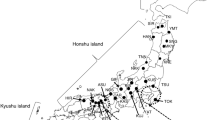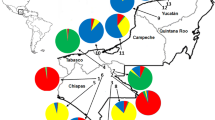Abstract
Phylogenetic relationships among cultivated landraces and natural populations of wild subspecies of Tartary buckwheat were investigated by constructing an NJ tree based on RAPD markers focussing on east Tibetan natural populations. Ten plants from three cultivated landraces and 29 plants from five natural populations of wild subspecies in eastern Tibet were used for RAPD analyses. The wild subspecies from eastern Tibet was classified into three types; (1) same type as cultivated landraces; (2) closely related to natural populations of northwestern Yunnan; and (3) an exceptional population, Zhuka, which was closely related to Sichuan populations. Since the type (2) is considered as the wild ancestral type of cultivated Tartary buckwheat, we conclude that eastern Tibet too may be one of the center of origin of this crop.
Similar content being viewed by others
References
Matsubara M. 1988. Seizou-kikou (Travels in Qinghai and Tibet). Chuoukouron-sha, Tokyo (in Japanese).
Ohnishi O. 1998a. Search for the wild ancestor of buckwheat III. The wild ancestor of cultivated common buckwheat and of Tatary buckwheat. Econ. Bot. 52: 123–133.
Ohnishi O. 1998b. Search for the wild ancestor of buckwheat I. Description of new Fagopyrum species and their distribution in China. Fagopyrum 15: 18–28.
Ohnishi O. 2000. Original birth place of Tartary buckwheat decuced from allozyme variations. Breeding Resarch 2.Suppl. 1: 248.
Saitou N. and Nei M. 1987. The neighbor joining method: A new method for reconstructing phylogenetic trees. Mol. Biol. Evol. 4: 406–425.
Tsuji K. and Ohnishi O. 1998. Phylogenetic relationships among cultivated landraces and natural populations of Tatary buckwheat (Fagopyrum tataricum) revealed by RAPD analyses. Proc. 7th Intl. Sym. Buckwheat, part VI: 41–49.
Tsuji K., Yasui Y. and Ohnishi O. 1999. Search for Fagopyrum species in eastern Tibet. Fagopyrum 16: 1–6.
Tsuji K. and Ohnishi O. 2000. Origin of cultivated Tartary buckwheat (Fagopyrum tataricum Gaert.) revealed by RAPD analyses. Genet. Resour. Crop Evol. 47: (in press)
Author information
Authors and Affiliations
Rights and permissions
About this article
Cite this article
Tsuji, K., Ohnishi, O. Phylogenetic position of east Tibetan natural populations in Tartary buckwheat (Fagopyrum tataricum Gaert.) revealed by RAPD analyses. Genetic Resources and Crop Evolution 48, 63–67 (2001). https://doi.org/10.1023/A:1011286326401
Issue Date:
DOI: https://doi.org/10.1023/A:1011286326401




